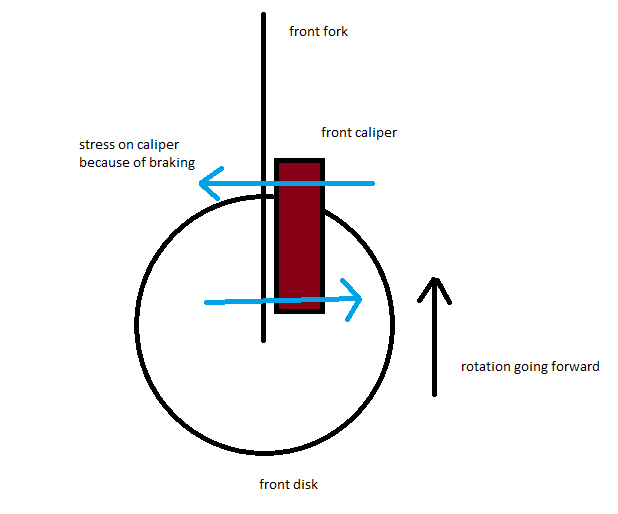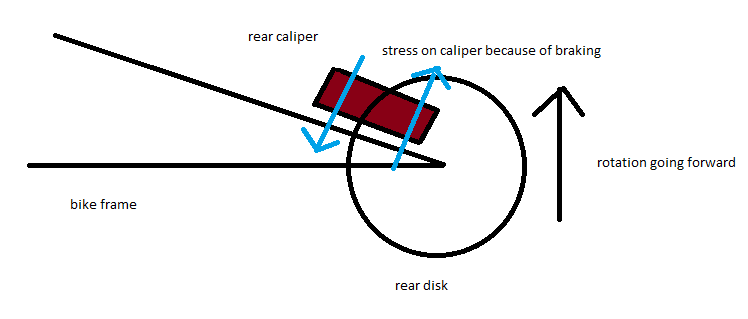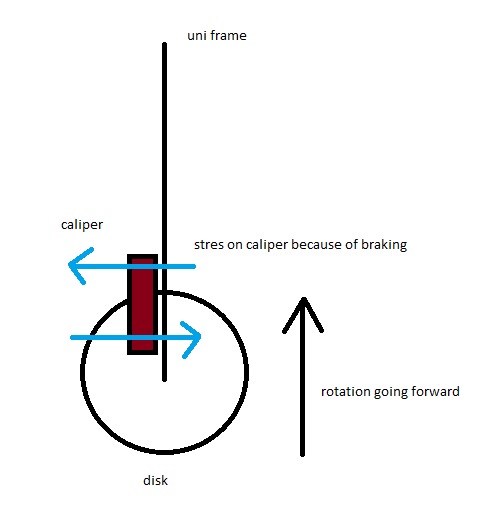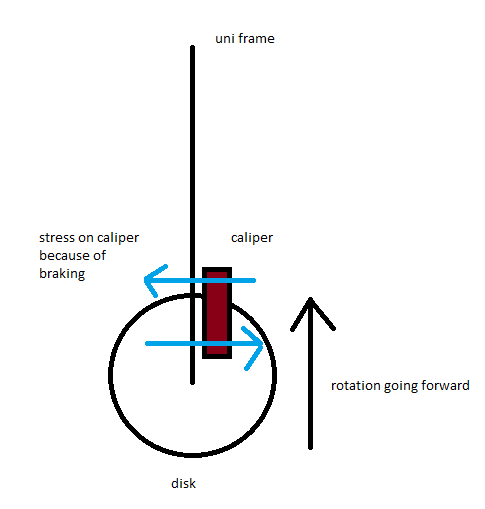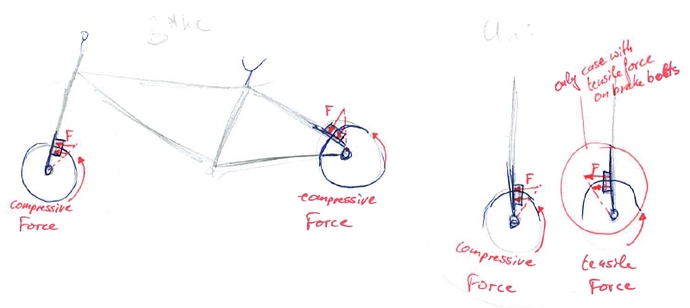Sidd, are you confusing v-brakes with disc brakes? V-brakes are on opposite sides (front brake in tension away from fork, rear brake in compression toward frame) but both front and rear disc brakes are on the same side.
I was focusing on the position of the caliper compared to the disk (caliper behind the disk on the front and caliper on top/slightly in front for the rear) and I totally forgot to consider the forces induced by the action of applying the brake.
I did 4 sketches on Paint just to summarize it and compare and it doesn’t look very differently from the existing 3 cases…
Now, it will be easier for me to see what I missed ![]()
You painted every caliper with one bolt under tensile force and one under compressive force. That isn’t right. The center of momentum for the Braking force is the center of the disc/wheel, not the center of the caliper.
Thanks for the links! I don’t think Qu-Ax was selling the frame alone when those unicycles first came out and I’ve only been checking at Goudurix lately since it’s easier and cheaper to ship to the US from Canada vs. Europe. I need to figure out what the clearance of that frame is compared to a Nimbus and if it fits my setup (3" Felt Berm Master on a 65mm rim) I’ll give it a try.
Well, an external rotor would be capable of stopping your feet which is marginally useful but has no effect on the wheel turning, as you know.
Yes, unicycle frames are generally symmetrical front to back with the exception of the slot for the seat post so you just have to turn around the clamp. I’ve had disc tabs put on the wrong side and did just that. I have a fixed 24" KH with the disc tab and I’ve wondered about riding with the caliper in front. I’m no engineer but that just doesn’t seem like a good idea. I’ve survived one braking accident unscathed (D’Brake snapped and mangled my rotor) and I don’t want to push my luck. Calipers are finicky enough running in the right direction.
Thanks! I’ve been focusing on improving my technical muni riding on fixed unicycles for the past year and when I ride my freewheels it’s been either my geared one or my peg unicycle. Now that the setting Winter sun has taken away my main technical trail I’m planning to ride my other freewheels more. Besides jumping I haven’t practiced tricks very much. I’d like to work on it more but I don’t have a great place to practice. I’d at least like to get proficient at pedaling backwards and get better at switch stance (left foot forward vs. my normal right foot forward). Have you seen Flaviu’s video:
Thanks Eric for the clarification ! I knew I was missing something but it is always clearer with a picture 
I don’t know how much stress the caliper has to deal with compared to a set of Magura but I remember seeing a couple of riders with the magura brakes on the front.
(back on topic  )
)
It’s great to have choices in production frames and to know that any steel frame can be modified at a reasonable price.
@waaalrus: What made you go for the steel tab ? Was it because of your D’Brake failure ? Or was there vibration/noise/something-else that did not feel right on an aluminum frame ?
It started in this thread. Back then I thought the problem might be the aluminum frame, possibly due to the difference in the modulus of elasticity between steel and aluminum. Now I’m thinking it was the combination of the aluminum frame with the aluminum D’Brake. Trying an aluminum frame with an aluminum disc tab might help to answer this question. I can’t speak to the engineering aspects of it but here’s the raw data:
- When I ride an aluminum frame (Nimbus Oracle) with a D'Brake (aluminum) I do not get sufficient braking. I can slow down OK but cannot come to a complete stop as quickly as I would like.
- A steel frame with a D'Brake (aluminum) gives me sufficient braking but I believe this combination caused the D'Brake to snap over time with the amount and force of braking that I do.
- A steel frame with a steel disc tab gives me the best braking experience I've had so far.
Why only marginally? I was thinking of trying that.
Since the disk is attached to the cranks (which on a freewheel, spin independent of the hub), when you apply the brake, the cranks won’t turn, but the hub will keep freewheeling. Accomplishing nothing.
I know how it works, I just thought locking the cranks might be more useful.
Over time locking my legs in a split position has become very natural although it requires effort. Locking the cranks could theoretically save some of this effort and would provide a more stable base in general but I’m not sure how useful that would be. I tend to think it would be more useful when I’m sitting in the saddle and have better leverage. In that case it would be more like regular coasting on a fixed unicycle. However, I usually am up off the saddle when I’m coasting for a long time on a freewheel unicycle. From a practical point of view it would be difficult for me to work two sets of brake handles and even if it was just the one that locks the cranks it’s a little harder to balance with one hand ready at the brake (although I do that now). More importantly, I don’t know if my muscle memory could adjust to the new pattern. The equipment is harder to come by, too (I have a set of Sinz cranks and a rotor that fits them but they’re ISIS and I would need cotterless). It’s an interesting idea, though!
Would a friction shifter work?
It might work over long, predictable terrain but more direct control is probably needed for any kind of variation.
While I’ve been focusing more on my technical muni skills on fixed wheel unicycles for the past year and have been somewhat sidetracked by peg unicycling I still make time for riding my freewheel unicycles.
I tried to do this last night but didn’t see how the caliper could fit. I did discover that my 26" freewheel (Halo SAS rim and Halo Twin Rail tire) fits in my 24" KH frame.
Not sure how that’d work, but I also have a 24" kh frame with a disc tab. I have no experience with disc brakes, but will be getting a disc hub and disc brake in a week or so!
For now my progress has been: rebuilt my 20" brakeless freewheel into a 24" with maggies. I can coast a few meters standing up on the pedals on flat ground. With hills and actual riding I cannot coast at all. I was unable to use the brake very well while practicing on tennis courts, but I took my unicycle to commute a bit.
Uphill: I was fine, except that I really suck at mounting uphill. I try to get my first foot to pull the pedal back, but I still always and up with my cranks up and down; then I jump and smack forward/down the 2nd pedal to get going. I either get it by luck, or my foot slips, or I stall. On flat ground, I don’t have to jump as hard or smack as hard and am also more likely to be able to ride out of a stall.
Downhill: I can pedal-brake-pedal-brake. I fall off when I don’t brake hard enough and lose too much speed before my center of mass is forward enough for me to pedal. Basically, I can pedal and bring the wheel in front, and also brake to bring the wheel behind me, but I cannot control either very well and oscillate quite wildly. I definitely cannot find the balance point yet, brake-coast-brake is out of the question right now.
Great video! And great progress! I like the seat drops at the end. The only thing you need now is a larger place to practice with maybe some gentle descents.
“I’ve been working on riding pump track style trails without using the brake. I’m comfortable at 6-8 MPH which lets me use pedaling for balance corrections. My goal is to push it to 10-12 MPH.”
Hi Waaalrus for documenting so well the techniques to use with a freewheeling unicycle.
One think I was wondering is: based on your experience, what is the friendlier freewheeling setup for a beginner ? Large or small wheel ? Fat, medium or skinny tire ?
(It is a bit the same question as for UW/BC wheels but the answer may prove to be different because of the frame/saddle/brake addition).
Thanks =)
I would say the answer is similar to a regular unicycle except that it’s harder to find a learner/starter. The question at the beginning is whether or not it’s something you will stick with so it’s nice (but unlikely) to find a cheap one you can try out or learn on. However, you’ll probably have to build your own wheel. Like a regular unicycle I don’t think there’s a huge difference between learning on a 20" or 24". A 26" is probably OK, too. The main question is where you plan to ride. The setup I ride the most is a 24" wheel (Large Marge rim and Felt Berm Master tire) on a steel Nimbus 24" muni frame with a disc tab welded on. The rim is the result of a failed experiment with trying a fat tire and a Nimbus or KH rim would probably be my first choice building new. The Felt Berm Master is a great tire for my purposes because I can run it at 40 psi on pavement and 30 psi on trails and it works pretty well on both although it’s hard to come by. The only mid fat 26" tire I’ve liked is the Duro Wildfire Leopard and I don’t know if there’s a good dual purpose tire in that size. I think a fat tire might be a bit much to learn on but I’m not certain. My 24" fat freewheel experiment was a failure because of the lack of variety of tires in that size. Now that I’ve ridden and enjoyed the 26" Surly Nate on a fixed unicycle I’m considering building a 26" fat freewheel. Before I build that wheel I’m waiting to see the results of another experiment. I ordered the aluminum Qu-Ax frame with a disc tab from UDC Germany and I want to see if that is a satisfying setup in terms of braking. As far as a frame it’s fine to go with what you have to start with and use the D’Brake. That is sufficient for the early learning phase. My own choices have been dictated by the types of riding that I do. I like the wider rims and tires because it lets me ride with less pressure to absorb bumps. If I was riding in a skate park I would probably go with a 20" and if I was riding a nice smooth pump track I could get away with a narrower wheel.
